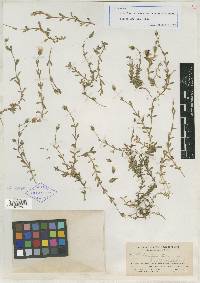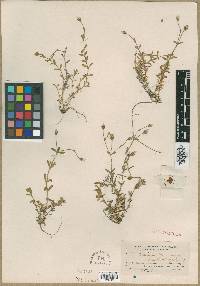
|
|
|
|
Family: Caryophyllaceae
Newfoundland Mouse-Ear Chickweed
|
Plants perennial, tufted, rhizom-atous. Stems loosely ascending to suberect, branched, very leafy, 10-15 cm, pubescence short, dense, glandular; small axillary tufts of leaves usually absent. Leaves tending to be marcescent, sessile but spatulate proximally; blade elliptic-oblong, 5-14 × 1.5-3.5 mm, apex obtuse, densely glandular-hirsute. Inflorescences lax, 1-3-flowered cymes; bracts ovate-lanceolate, margins very narrow, scarious, glandular-pubescent. Pedicels mostly erect, slender, 10-25 mm, 1-4 times as long as sepals, densely glandular-pubescent. Flowers: sepals ovate-oblong, 5.5-6.5 mm, elongating to 6-7 mm in fruit, margins broad, apex obtuse, glandular-pubescent; petals narrowly oblanceolate, 7-10 mm, 1.5-2 times as long as sepals, apex 2-fid; stamens 10; styles 5. Capsules ovate-cylindric, ca. straight, short, broad, 9-13 mm, ca. 2 times as long as sepals; teeth 10, erect or partially spreading, margins convolute. Seeds brown, 1.3-1.7 mm diam., with prominent papillae around margins and rows of small, transverse ridges on sides; testa inflated, loose (rubs off when rolled between finger and thumb). 2n = 108. Flowering summer. Serpentine gravel, sands, rocky tablelands; 20-700 m; Nfld. and Labr. (Nfld.). Cerastium terrae-novae is the only member of the European C. nigrescens group of species to occur in North America. The group is distinguished by large seeds with loose testae. Cerastium terrae-novae is distinguished by its narrowly elliptic leaves, usually purple-suffused stems and sepals, broad, straight capsule, short pubescence, and poorly developed inflorescence that often is reduced to a single flower.
FNA 2005, Kearney and Peebles 1969, McDougal 1973 Duration: Perennial Nativity: Native Lifeform: Forb/Herb General: Herbaceous perennial, to 20 cm tall, stems slender, very leafy, herbage pilose, the pubescence short, dense, and glandular, especially towards the base of the stems. Leaves: Opposite, 2-4 on the lower part of the stem, sessile, spatulate to oblanceolate or obovate, 8-15 mm long, 1.5-3.5 mm wide, sparsely pilose on both sides, often persistent after withering. Flowers: White, small, few, petals narrowly oblanceolate, slightly longer than the sepals at 7-10 mm, the apices cleft into 2 parts, sepals ovate-oblong, 5.5-6.5 mm long, elongating in fruit, bracts ovate-lanceolate, the margins narrow and scarious, stamens 10, styles 5, pedicels densely glandular-pubescent, flowers borne in groups of 1-3 in lax, terminal cymes. Fruits: Elongate, straight, ovate-cylindric, dehiscent capsule, 9-13 mm long, the 10 teeth of the capsule strongly revolute, erect, or partially spreading at maturity, borne on pedicels usually much longer than the capsules. Seeds brown, 1-2 mm in diameter with p Ecology: Found on serpentine gravel and sands, in rocky tablelands and moist, shady places, from 100-2,500 ft (30-762 m); flowering March-May, and occasionally into late summer. Distribution: Texas, Arizona. Notes: Look for this species under Cerastium texanum in older texts. The strongly revolute teeth of the capsules and the annual longevity help identify this species. Ethnobotany: Unknown Synonyms: Cerastium texanum, Cerastium beeringianum subsp. terrae-novae Editor: LCrumbacher 2011 Etymology: Cerastium comes from the Greek keras, "a horn," referring to the shape of the seed capsule, while the meaning of terrae-novae is unknown. |
This project was made possible in part by the Institute of Museum and Library Services [MG-70-19-0057-19].
Powered by Symbiota





